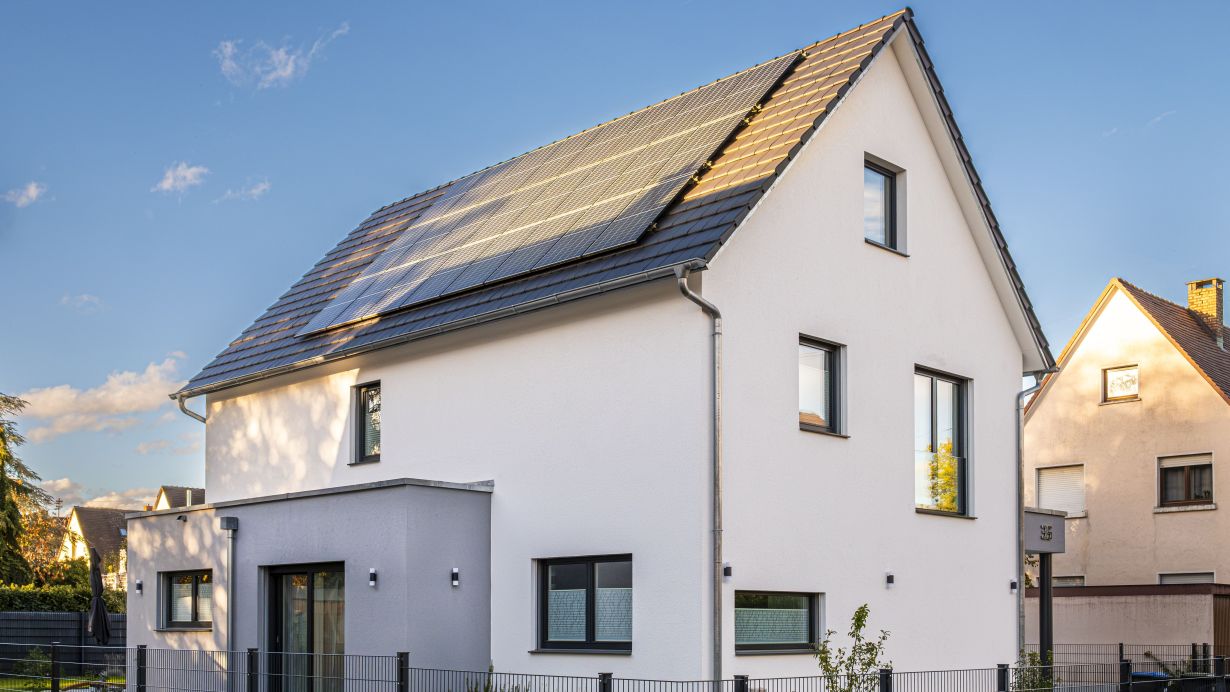Independence in energy supply is increased by the combined use of photovoltaic facilities and energy storage systems. Researchers of Karlsruhe Institute of Technology (KIT) and partners have now calculated potential energy self-sufficiency of residential buildings. In Joule, they report that 53 percent of all single-family homes in Europe may become self-sufficient today already. By 2050, a further two million buildings could be off-grid with an additional 50 per cent investment. (DOI: https://doi.org/10.1016/j.joule.2023.09.012)
Electricity costs in Europe have been increasing for years. After Russia started to attack Ukraine, costs have reached a record level according to calculations by Eurostat. At the same time, photovoltaic facilities and battery storage systems make it easier for customers to become more independent of utility companies. “When investing in local energy supply systems, most of the own electricity consumption can be covered by the customers themselves and high electricity costs will be reduced,” says main author Max Kleinebrahm, who heads a working group at KIT’s Institute for Industrial Production (IIP). An increasing number of building owners in Europe decide to increase their autonomy. “This decision is not only influenced by economic criteria. Also non-monetary aspects play a role, such as a high share of renewable energies and the wish to use no nuclear and fossil energy and to be highly self-sufficient.” A team of KIT researchers, in cooperation with researchers of Forschungszentrum Jülich, ETH Zurich, and the Paul Scherrer Institute, have now calculated how big the step from partly independent power and heat supply to complete self-sufficiency would be.
How Much Energy Independence Can Private Households Achieve?
Their calculations are based on a database that combines geographically highly resolved information on existing buildings in Europe and the corresponding households with the local climatic and economic conditions. Using novel complexity reduction methods on supercomputers, cost-optimized self-sufficient supply systems were configured for initially 4000 representative single-family homes. Then, neural networks were applied to transfer the results to the 41 million single-family homes studied. “Under today’s conditions, 53 percent of the 41 million buildings are technically capable of reaching self-sufficiency by the use of solar radiation from the roof. Use of improved technologies would increase this proportion to 75 percent by 2050,” says Professor Russell McKenna from ETH Zurich, who heads the Energy Systems Analysis Lab of the Paul Scherrer Institute in Switzerland. “If building owners invested up to 50 percent more than required for a comparable grid-connected energy system connected to the grid, up to 2 million single-family homes could be self-sufficient by 2050.”
According to the researchers, the potential for self-sufficiency is greatest in regions with little seasonal weather variations, such as Spain, or in regions with high electricity costs, such as Germany. The configuration of cost-optimized energy systems is clear: “According to our findings, a successful cost-optimized and self-sufficient energy supply system for buildings in Central Europe consists of photovoltaics for electricity generation and short-term battery storage combined with long-term, seasonal hydrogen storage,” says Dr. Jann Weinand, Department Head at Forschungszentrum Jülich.
More Stability for the Energy System
The impact of a widespread use of self-sufficient supply systems on the European energy system still needs to be analyzed, but the researchers expect it to be positive. “Residential buildings that are partly independent in energy supply may help stabilize the overall energy system in the future. Lower household demand could reduce the need for peak-load power plants,” says Elias Naber from IIP. “However, a complete decoupling from the grid must be prevented, for example by granting special electricity tariffs to building owners for grid-friendly behavior.”
Original Publication
Max Kleinebrahm, Jann Michael Weinand, Elias Naber, Russell McKenna, Armin Ardone, Wolf Fichtner: Two million European single-family homes could abandon the grid by 2050. (2023) https://doi.org/10.1016/j.joule.2023.09.012
More about the KIT Energy Center
In close partnership with society, KIT develops solutions for urgent challenges – from climate change, energy transition and sustainable use of natural resources to artificial intelligence, sovereignty and an aging population. As The University in the Helmholtz Association, KIT unites scientific excellence from insight to application-driven research under one roof – and is thus in a unique position to drive this transformation. As a University of Excellence, KIT offers its more than 10,000 employees and 22,800 students outstanding opportunities to shape a sustainable and resilient future. KIT – Science for Impact.

